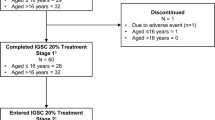Abstract
The purpose of the study was to evaluate the safety, efficacy, and pharmacokinetics of Flebogamma® 5%, an immune globulin intravenous product, for replacement therapy in primary immunodeficient patients. The US Food and Drug Administration has proposed that the use of new products must result in ≤1 serious bacterial infection/subject/year, have acceptable safety and tolerability, and have pharmacokinetic properties similar to endogenous IgG and other commercially available immune globulin products. Flebogamma® 5% was administered at seven clinical sites to 51 subjects aged 14–74 years with well-defined primary immunodeficiency diseases at a dose of 300–600 mg/kg every 21–28 days for 12 months. The calculated serious infection rate for the intent-to-treat population was 0.061/subject/year. The incidence of adverse events considered potentially related to Flebogamma® 5%, and occurring during or within 72 h after completing the infusion was approximately 8%. The half-life of total IgG was 37 days. Flebogamma® 5% is efficacious, safe, and well-tolerated, and does not put subjects at increased risk of adverse events other than those that could be reasonably expected in primary immunodeficient subjects who are receiving any immune globulin product.
Similar content being viewed by others
REFERENCES
Primary immunodeficiency diseases: Report of a WHO sponsored meeting. Immunodefic Rev 1:173–205, 1989
Buckley RH, Schiff RI: The use of intravenous immune globulin in immunodeficiency diseases. N Engl J Med 325(2):110–117, 1991
Cooper MD, Lawton AR: Primary immunodeficiency diseases. In Harrison's Principles of Internal Medicine, AS Fauci, E Braunwald, KJ Isselbacher, et al. (eds). NewYork, McGraw-Hill, 1998, pp 1783–1791
Lever AM, Webster AD, Brown D, Thomas HC: Non-A non B-hepatitis occurring in agammaglobulinemic patients after intra-venous immunoglobulin. Lancet 2:1062–1274, 1990
Lehner PJ, Webster AD: Hepatitis C from immunoglobulin infu-sions. BMJ 306:1541–1542, 1993
Centers for Disease Control: Outbreak of hepatitis C associated with intravenous immunoglobulin administration–United States, October 1993–1994. Morb Mortal Wkly Rep 43:505–509, 1994
Centers for Disease Control: Availability of immune globulin intra-venous for treatment of immune deficient patients–United States, 1997–1998. Morb Mortal Wkly Rep 48(8):159–162, 1999
Liese JG, Wintergerst U, Tympner KD, Belohradsky BH: High-vs. low-dose immunoglobulin therapy in the long-term treatment of X-linked agammaglobulinemia. Am J Dis Child 146(3):335–339, 1992
Roifman CM, Lederman HM, Lavi S, Stein LD, Levison H, Gelfand EW: Benefit of intravenous IgG replacement in hypogammaglob-ulinemic patients with chronic sinopulmonary disease. Am J Med 79(2):171–174, 1985
Cunningham-Rundles C, Siegal FP, Smithwick EM, Lion-Boule A, Cuningham-Rundles S, O'Mally J, Barandun S, Good RA: Efficacy of intravenous immunoglobulin in primary humoral immunodefi-ciency disease. Ann Intern Med 101(4):435–439, 1984
Francis F, Green M, Payne C: GLIM 4. The Statistical System for Generalized Linear Interactive Modeling. Oxford, Clarendon Press, 1993
Ochs HD, Morell A, Skvaril F, Fischer SH, Wedgwood RJ: Survival of IgG subclasses following administration of intravenous gamma-globulin in patients with primary immunodeficiency diseases. In Clinical Use of Intravenous Immunoglobulins. Morell A and Ny-degger UE (eds.), London, Academic Press, 1986, pp 77–85
Fischer SH, Ochs HD, Wedgwood RJ, Skvaril F, Morell A, Hill HR, Schiffmann G, Corey L: Survival of antigen-specific antibody following administration of intravenous immunoglobulin in patients with primary immunodeficiency diseases. Monogr Allergy 23:225–235, 1988
Mankarious S, Lee M, Fischer S, Pyun KH, Ochs HD, Oxelius VA, Wedgwood RJ: The half-lives of IgG subclasses and specific anti-bodies in patients with primary immunodeficiency who are receiv-ing intravenously administered immunoglobulin. J Lab Clin Med 112(5):634–640, 1988
Andresen I, Kovarik JM, Spycher M, Bolli R: Product equivalence study comparing the tolerability, pharmacokinetics, and pharmaco-dynamics of various human immunoglobulin-G formulations. J Clin Pharmacol 40:722–730, 2000
Thürmann PA, Sonnenburg-Chatzopoulos C, Lissner R: Pharma-cokinetic characteristics and tolerability of a novel intravenous im-munoglobulin preparation. Eur J Clin Pharmacol 49:237–242, 1995
Schiff RL: Half-life and clearance of pH 6.8 and pH 4.25 immunoglobulin G intravenous preparations in patients with primary disorders of humoral immunity. Rev Infect Dis 8(Suppl 4):S449–S456, 1986
Author information
Authors and Affiliations
Rights and permissions
About this article
Cite this article
Berger, M., Pinciaro, P.J. & Flebogamma Safety, Efficacy, and Pharmacokinetics of Flebogamma® 5% [Immune Globulin Intravenous (Human)] for Replacement Therapy in Primary Immunodeficiency Diseases. J Clin Immunol 24, 389–396 (2004). https://doi.org/10.1023/B:JOCI.0000029108.18995.61
Issue Date:
DOI: https://doi.org/10.1023/B:JOCI.0000029108.18995.61




